Python IDE
This article recommends several good Python IDEs (integrated development environments) for everyone. PyCharm is more recommended. Of course, you can choose the Python IDE that suits you according to your preferences.
PyCharm
PyCharm is a Python IDE built by JetBrains.
PyCharm has the functions of general Python IDE, such as: debugging, syntax highlighting, project management, code jump, smart prompts, auto-completion, unit testing, version control, etc.
In addition, PyCharm also provides some great features for Django development and supports Google App Engine. What’s even cooler is that PyCharm supports IronPython.
PyCharm official download address: http://www.jetbrains.com/pycharm/download/
Rendering view:

Sublime Text
The software is charged, but supports permanent trial.
Sublime Text has a beautiful user interface and powerful features such as code thumbnails, plug-ins for Python, code snippets, etc. Key bindings, menus and toolbars can also be customized.
Sublime Text’s main features include: spell check, bookmarks, complete Python API, Goto function, instant project switching, multi-selection, multi-window and more.
Sublime Text is a cross-platform editor that also supports Windows, Linux, Mac OS X and other operating systems.
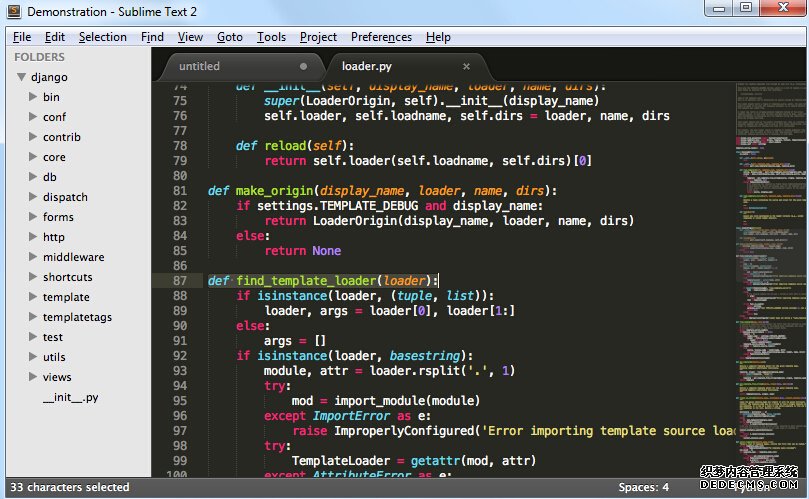
Using the Sublime Text plug-in extension function, you can easily create a good Python IDE. Here are several plug-ins recommended (you can find more):
CodeIntel: auto-completion + member/method prompts ( Highly recommended)
SublimeREPL: used to run and debug some programs that require interaction (E.G. programs using Input())
Bracket Highlighter: bracket matching and highlighting
SublimeLinter: code pep8 format check
Eclipse+Pydev
1. Install Eclipse
Eclipse can be found and downloaded on its official website Eclipse.org. Usually we can choose the Eclipse version that suits us, such as Eclipse Classic. After the download is complete, unzip it to the directory you want to install.
Of course before executing Eclipse, you must confirm that the Java runtime environment is installed, that is, JRE or JDK must be installed. You can go to (http://www.java.com/en/download/manual.jsp) to find the JRE download and Install.
2. Install Pydev
After running Eclipse, select help-->Install new Software, as shown in the figure below.
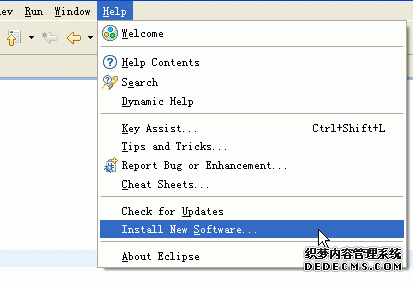
Click Add to add the installation address of pydev: http://pydev.org/updates/, as shown in the picture below.
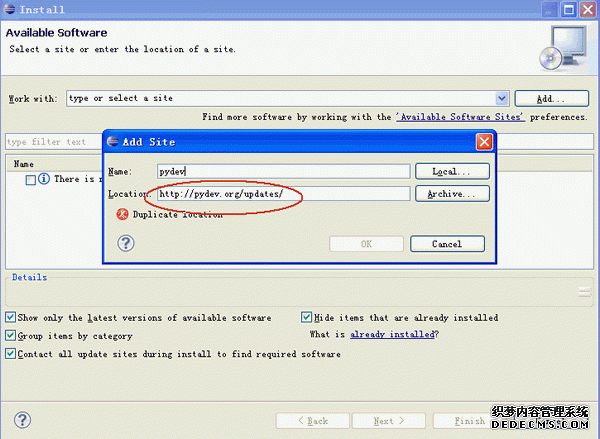
Click "ok" after completion, then click "+" of PyDev to expand the PyDev node. Wait for a short period of time for it to obtain PyDev related packages from the Internet. When completed, there will be more PyDev The relevant packages are in the sub-nodes, check them and press next to install them. As shown below.

After the installation is completed, restart Eclipse
3. Set up Pydev
After the installation is completed, you still need to set up PyDev, select Window -> Preferences to set up PyDev. Set the path of Python and select New
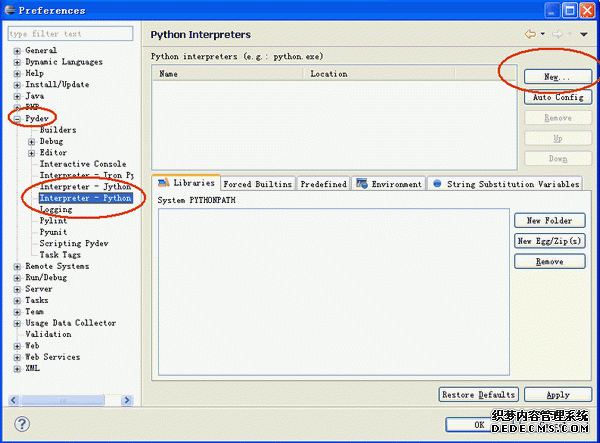
from Pydev's Interpreter - Python page. A window will pop up allowing you to select the installation location of Python and select the location where you installed Python.
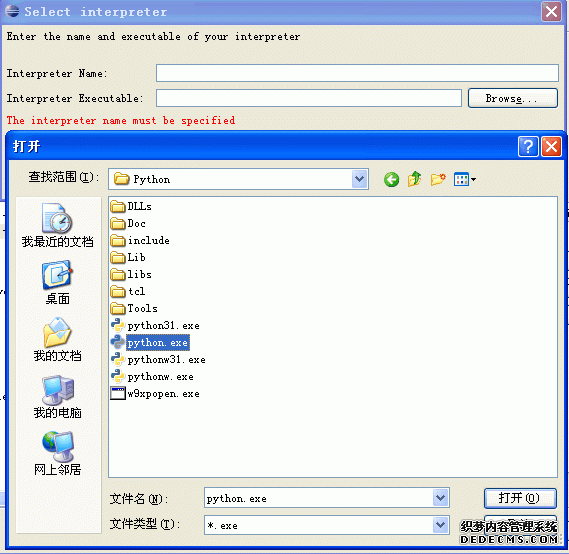
After completion, PyDev is set up and can be started.
4. Establish Python Project:
After installing Eclipse+PyDev, we can start using it to develop projects. First, create a project, select File -> New ->Pydev Project
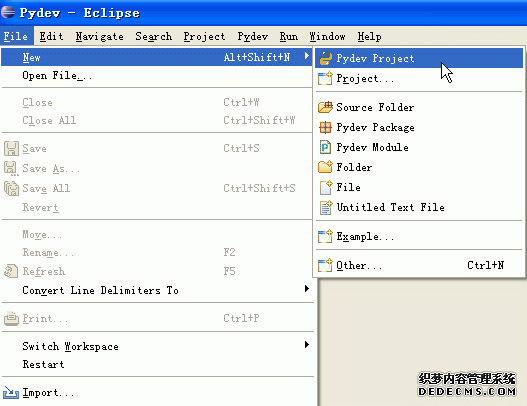
. A new window will pop up, fill in the Project Name, and the project save address, and then click next to complete the creation of the project.
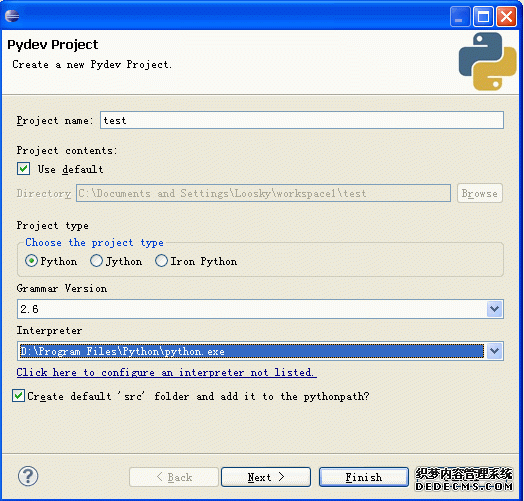
5. Creating a new Pydev Module
It is impossible to execute the project alone. Then you must create a new Pydev Module and select File -> New -> Pydev Module
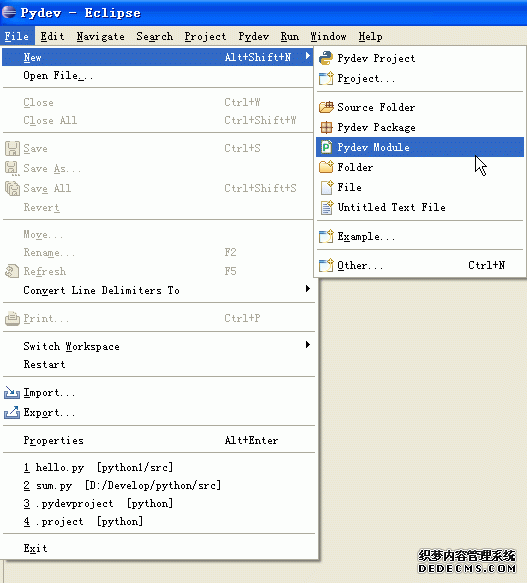
in the pop-up window Select the file storage location and Moudle Name. Note that there is no need to add .py to the Name, it will automatically help us add it. Then click Finish to complete the creation.
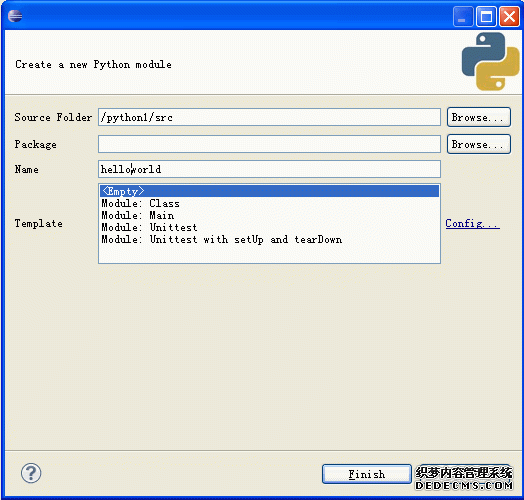
Enter the code for "hello world".
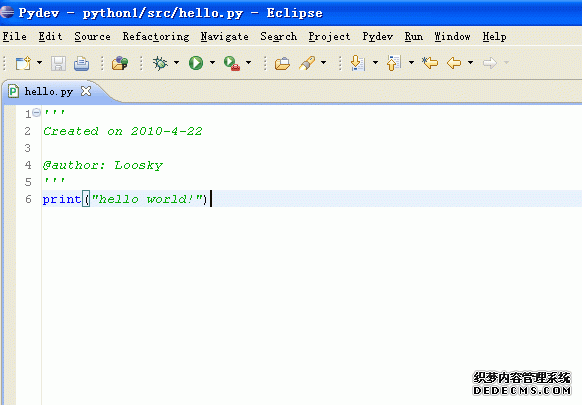
6. Execute the program
After the program is written, we can start executing the program and find the execution button on the upper toolbar.
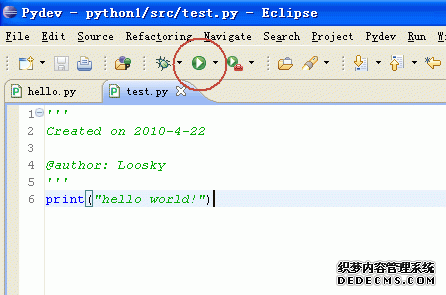
A window will pop up allowing you to choose the execution method. Usually we choose Python Run to start executing the program.
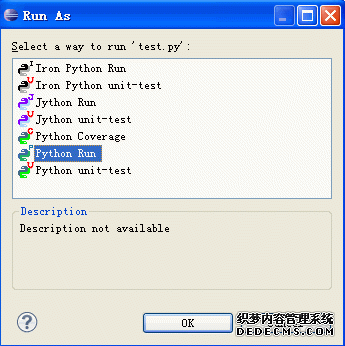

Hot AI Tools

Undresser.AI Undress
AI-powered app for creating realistic nude photos

AI Clothes Remover
Online AI tool for removing clothes from photos.

Undress AI Tool
Undress images for free

Clothoff.io
AI clothes remover

Video Face Swap
Swap faces in any video effortlessly with our completely free AI face swap tool!

Hot Article

Hot Tools

Notepad++7.3.1
Easy-to-use and free code editor

SublimeText3 Chinese version
Chinese version, very easy to use

Zend Studio 13.0.1
Powerful PHP integrated development environment

Dreamweaver CS6
Visual web development tools

SublimeText3 Mac version
God-level code editing software (SublimeText3)

Hot Topics
 1665
1665
 14
14
 1423
1423
 52
52
 1321
1321
 25
25
 1269
1269
 29
29
 1249
1249
 24
24
 Python vs. C : Applications and Use Cases Compared
Apr 12, 2025 am 12:01 AM
Python vs. C : Applications and Use Cases Compared
Apr 12, 2025 am 12:01 AM
Python is suitable for data science, web development and automation tasks, while C is suitable for system programming, game development and embedded systems. Python is known for its simplicity and powerful ecosystem, while C is known for its high performance and underlying control capabilities.
 Python: Games, GUIs, and More
Apr 13, 2025 am 12:14 AM
Python: Games, GUIs, and More
Apr 13, 2025 am 12:14 AM
Python excels in gaming and GUI development. 1) Game development uses Pygame, providing drawing, audio and other functions, which are suitable for creating 2D games. 2) GUI development can choose Tkinter or PyQt. Tkinter is simple and easy to use, PyQt has rich functions and is suitable for professional development.
 Python vs. C : Learning Curves and Ease of Use
Apr 19, 2025 am 12:20 AM
Python vs. C : Learning Curves and Ease of Use
Apr 19, 2025 am 12:20 AM
Python is easier to learn and use, while C is more powerful but complex. 1. Python syntax is concise and suitable for beginners. Dynamic typing and automatic memory management make it easy to use, but may cause runtime errors. 2.C provides low-level control and advanced features, suitable for high-performance applications, but has a high learning threshold and requires manual memory and type safety management.
 Python and Time: Making the Most of Your Study Time
Apr 14, 2025 am 12:02 AM
Python and Time: Making the Most of Your Study Time
Apr 14, 2025 am 12:02 AM
To maximize the efficiency of learning Python in a limited time, you can use Python's datetime, time, and schedule modules. 1. The datetime module is used to record and plan learning time. 2. The time module helps to set study and rest time. 3. The schedule module automatically arranges weekly learning tasks.
 Python vs. C : Exploring Performance and Efficiency
Apr 18, 2025 am 12:20 AM
Python vs. C : Exploring Performance and Efficiency
Apr 18, 2025 am 12:20 AM
Python is better than C in development efficiency, but C is higher in execution performance. 1. Python's concise syntax and rich libraries improve development efficiency. 2.C's compilation-type characteristics and hardware control improve execution performance. When making a choice, you need to weigh the development speed and execution efficiency based on project needs.
 Python: Automation, Scripting, and Task Management
Apr 16, 2025 am 12:14 AM
Python: Automation, Scripting, and Task Management
Apr 16, 2025 am 12:14 AM
Python excels in automation, scripting, and task management. 1) Automation: File backup is realized through standard libraries such as os and shutil. 2) Script writing: Use the psutil library to monitor system resources. 3) Task management: Use the schedule library to schedule tasks. Python's ease of use and rich library support makes it the preferred tool in these areas.
 Which is part of the Python standard library: lists or arrays?
Apr 27, 2025 am 12:03 AM
Which is part of the Python standard library: lists or arrays?
Apr 27, 2025 am 12:03 AM
Pythonlistsarepartofthestandardlibrary,whilearraysarenot.Listsarebuilt-in,versatile,andusedforstoringcollections,whereasarraysareprovidedbythearraymoduleandlesscommonlyusedduetolimitedfunctionality.
 Learning Python: Is 2 Hours of Daily Study Sufficient?
Apr 18, 2025 am 12:22 AM
Learning Python: Is 2 Hours of Daily Study Sufficient?
Apr 18, 2025 am 12:22 AM
Is it enough to learn Python for two hours a day? It depends on your goals and learning methods. 1) Develop a clear learning plan, 2) Select appropriate learning resources and methods, 3) Practice and review and consolidate hands-on practice and review and consolidate, and you can gradually master the basic knowledge and advanced functions of Python during this period.




